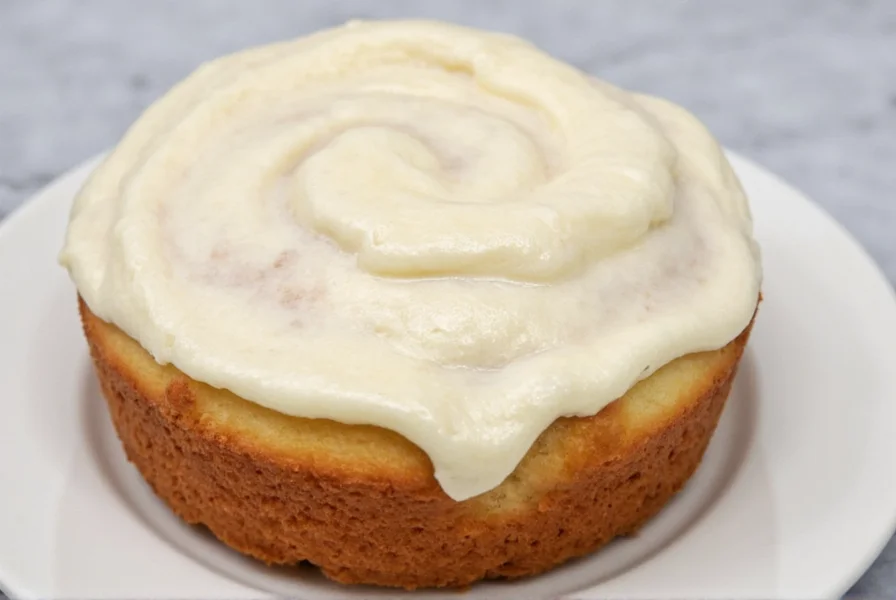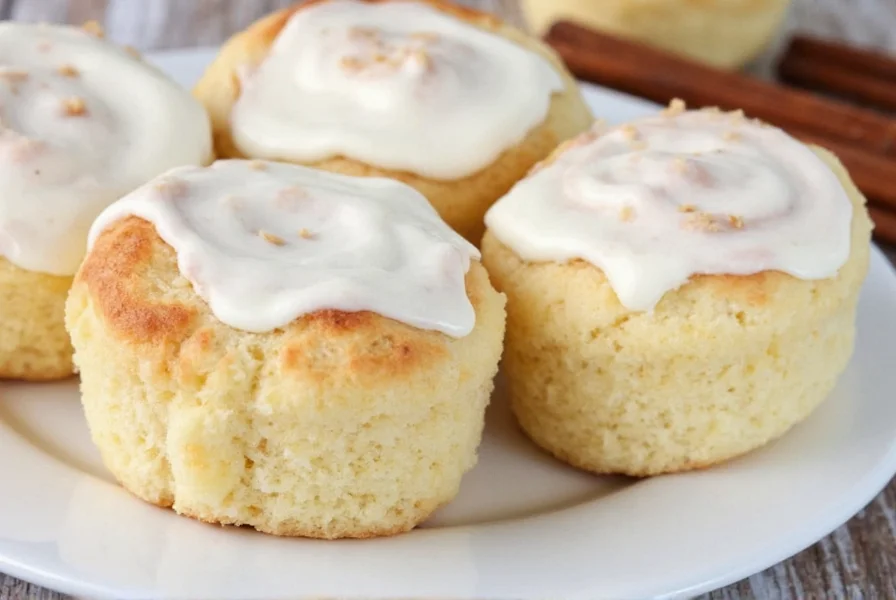The perfect cinnamon roll frosting recipe combines 4 ounces of softened cream cheese, 1/4 cup unsalted butter, 1 cup powdered sugar, 1/2 teaspoon vanilla extract, and 1-2 tablespoons of milk. Whip until smooth and creamy, then spread immediately over warm cinnamon rolls. This basic cream cheese frosting ratio creates the ideal balance of tangy and sweet that complements cinnamon rolls without overwhelming them. For a traditional powdered sugar glaze, use 1 cup powdered sugar, 1-2 tablespoons milk, and 1/2 teaspoon vanilla instead.
Nothing completes a batch of freshly baked cinnamon rolls like the perfect frosting. While some prefer the classic powdered sugar glaze, cream cheese frosting has become the gold standard for its rich, tangy contrast to the sweet, spicy rolls. After testing dozens of variations, we've perfected a foolproof cinnamon roll frosting recipe that delivers consistent results every time—creamy, spreadable, and flavorful without being overly sweet.
Why This Cinnamon Roll Frosting Recipe Works
The magic of great cinnamon roll frosting lies in the balance of ingredients. Too much liquid makes it runny; too little creates a stiff paste. The ideal frosting should be thick enough to cling to the rolls but soft enough to spread easily. Our tested recipe achieves this balance through precise measurements and proper technique. Unlike many online recipes that use vague instructions like "add milk until right," we provide exact measurements that work consistently in various kitchen conditions.
Essential Ingredients for Perfect Cinnamon Roll Frosting
Quality ingredients make the difference between good and exceptional frosting. Here's what you'll need for the cream cheese version:
| Ingredient | Amount | Why It Matters |
|---|---|---|
| Cream cheese, full-fat | 4 ounces (113g) | Provides rich tanginess and structure; low-fat versions create watery frosting |
| Unsalted butter, softened | 1/4 cup (57g) | Adds richness and helps emulsify the frosting |
| Powdered sugar, sifted | 1 cup (120g) | Sweetness and texture; sifting prevents lumps |
| Vanilla extract | 1/2 teaspoon | Enhances flavor complexity |
| Milk or cream | 1-2 tablespoons | Adjusts consistency; start with 1 tablespoon |
Step-by-Step Cream Cheese Frosting Instructions
- Prepare ingredients: Ensure cream cheese and butter are at true room temperature (about 70°F/21°C). Cold ingredients won't blend properly.
- Cream base: In a medium bowl, beat cream cheese and butter with an electric mixer on medium speed for 2 minutes until completely smooth and no lumps remain.
- Add sugar: Gradually add sifted powdered sugar, 1/4 cup at a time, beating on low speed to avoid a sugar cloud.
- Finish texture: Add vanilla and 1 tablespoon milk. Beat on medium-high for 1 minute until light and fluffy. If too thick, add remaining milk 1 teaspoon at a time.
- Apply immediately: Spread over warm (not hot) cinnamon rolls using an offset spatula for even coverage.

Popular Cinnamon Roll Frosting Variations
While the classic cream cheese version reigns supreme, these tested variations offer delicious alternatives:
Traditional Powdered Sugar Glaze
For those who prefer the classic bakery-style icing, combine 1 cup sifted powdered sugar, 1-2 tablespoons milk, and 1/2 teaspoon vanilla. Whisk until smooth. Add milk sparingly until it reaches a thick but pourable consistency. This easy cinnamon roll frosting recipe without cream cheese works perfectly for those avoiding dairy or wanting a lighter topping.
Vegan Cinnamon Roll Frosting
Substitute vegan butter and vegan cream cheese (like Kite Hill or Miyoko's). Use 3 tablespoons unsweetened almond milk instead of dairy milk. The best vegan cinnamon roll icing maintains the creamy texture while being completely plant-based.
Lemon-Infused Frosting
Add 1 tablespoon fresh lemon zest and 1 teaspoon lemon juice to the basic cream cheese recipe. The citrus brightens the rich frosting, creating a sophisticated flavor profile that cuts through the sweetness—a perfect cinnamon roll topping idea for brunch occasions.
Troubleshooting Common Frosting Problems
Even with the best cinnamon roll frosting from scratch recipe, issues can arise. Here's how to fix them:
- Runny frosting: You've likely added too much liquid or used ingredients that were too warm. Chill the frosting for 15-20 minutes, then beat in additional sifted powdered sugar (1 tablespoon at a time).
- Grainy texture: Powdered sugar wasn't sifted or ingredients weren't fully incorporated. Beat on medium speed for 2-3 minutes longer, ensuring the bowl sides are scraped frequently.
- Too sweet: Add a pinch of salt or 1/8 teaspoon cream of tartar to balance the sweetness without altering texture.
- Not tangy enough: For a more pronounced cream cheese flavor, reduce butter to 3 tablespoons and increase cream cheese to 5 ounces.
Storage and Serving Tips
For optimal results with your thick cinnamon roll frosting recipe:
- Always apply frosting to warm rolls (140-160°F) so it melts slightly into the crevices without running off
- Store frosted rolls covered at room temperature for up to 24 hours
- For longer storage, keep unfrosted rolls frozen, then thaw and apply fresh frosting before serving
- Leftover frosting keeps in an airtight container in the refrigerator for up to 5 days—bring to room temperature and re-whip before using
Why Most Cinnamon Roll Frosting Recipes Fail
Many online cinnamon roll icing recipes suffer from critical flaws that lead to disappointing results. Common mistakes include:
- Vague instructions like "add milk until right" instead of precise measurements
- Using cold ingredients that create lumpy frosting
- Incorrect sugar-to-liquid ratios that cause runny or stiff results
- Not specifying full-fat dairy products, leading to watery frosting
Our tested recipe eliminates these issues with exact measurements and clear technique guidance, ensuring bakery-quality results in your home kitchen every time you make homemade cinnamon roll icing.
Frequently Asked Questions
Can I make cinnamon roll frosting without powdered sugar?
Yes, you can create a delicious frosting using 1/2 cup heavy cream whipped to stiff peaks, folded into 4 ounces of sweetened cream cheese. This alternative works well for those avoiding refined sugars, though it has a lighter texture than traditional frosting.
How do I prevent my cinnamon roll frosting from melting off?
Apply frosting to rolls that are warm but not hot (140-160°F). Rolls straight from the oven will melt the frosting too much, causing it to run off. If your kitchen is very warm, chill the frosting slightly before applying to help it set faster.
What's the ideal ratio for cinnamon roll glaze?
The perfect powdered sugar glaze ratio is 1 cup powdered sugar to 1.5-2 tablespoons liquid (milk or cream). Start with 1 tablespoon liquid, then add more sparingly until it reaches a thick but pourable consistency that coats the back of a spoon.
Can I make cinnamon roll frosting ahead of time?
Yes, store prepared frosting in an airtight container in the refrigerator for up to 5 days. Before using, bring to room temperature and re-whip with an electric mixer for 1-2 minutes to restore its creamy texture. Do not freeze frosting as it will separate upon thawing.
Why does my cream cheese frosting become watery?
Watery frosting usually results from using low-fat cream cheese, ingredients that were too warm, or overbeating. Full-fat cream cheese is essential for proper structure. If your frosting becomes watery, chill it thoroughly, then beat in additional sifted powdered sugar (1 tablespoon at a time) until it regains proper consistency.











 浙公网安备
33010002000092号
浙公网安备
33010002000092号 浙B2-20120091-4
浙B2-20120091-4